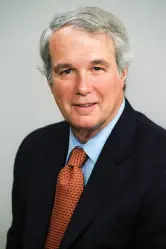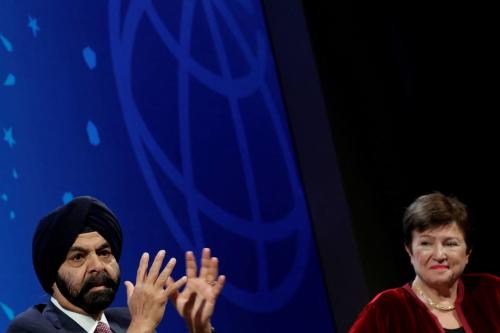Executive Summary
At the invitation of President George W. Bush, the G20 leaders met on November 15, 2008, in Washington, DC, in response to the worldwide financial and economic crisis. With this summit meeting the reality of global governance shifted surprisingly quickly. Previously, major global economic, social and environmental issues were debated in the small, increasingly unrepresentative and often times ineffectual circle of G8 leaders. Now, there is a larger, much more legitimate summit group which can speak for over two-thirds of the world’s population and controls 90% of the world’s economy.
The successful first G20 Summit provides a platform on which President-elect Obama can build in forging an inclusive and cooperative approach for resolving the current financial and economic crisis. Rather than get embroiled in a debate about which country is in and which country is out of the summit, the new U.S. administration should take a lead in accepting the new summit framework for now and focus on the substantive issues. Aside from tackling the current crisis, future G20 summits should also drive the reform of the international financial institutions and address other major global concerns—climate change, poverty and health, and energy among others. With its diverse and representative membership of key countries and with a well-managed process of summit preparation and follow-up the new G20 governance structure would allow for a more inclusive deliberation and more effective response to today’s complex global challenges and opportunities.
Policy Brief #168
A Successful G20 Summit—A Giant Step Forward
Once announced, there was speculation that the G20 Summit would be at best a distraction and at worst a costly failure, with a lame duck U.S. president hobbled by a crisis-wracked economy and a president-elect impotently waiting at the sidelines, with European leaders bickering over seemingly arcane matters, and with the leaders of the emerging economies sitting on the fence, unwilling or unprepared to take responsibility for fixing problems not of their making.
As it turned out, the first G20 Summit was by most standards a success. It served as a platform for heads of state to address the current financial turmoil and the threats of the emerging economic crisis facing not only the U.S. and Europeans, but increasingly also the rest of the world. The communiqué unmistakably attributes blame for the crisis where it belongs—to the advanced countries. It lays out a set of principles and priorities for crisis management and an action plan for the next four months and beyond, and it promises to address the longer-term agenda of reform of the global financial system. Very importantly, it also commits the leaders to meet again in April 2009 under the G20 umbrella. This assures that the November G20 Summit was not a one-off event, but signified the beginning of a new way of managing the world economy. The U.S. Treasury, which apparently drove the decision to hold the G20 rather than a G8 summit and which led the brief preparation process, deserves credit for this outcome.
A Long Debate over Global Governance Reform Short-circuited
With this successful summit a number of unresolved issues in global governance were pushed aside virtually overnight:
- The embarrassing efforts of past G8 summits to reach out to the leaders of emerging market economies with ad hoc invitations to join as part-time guests or through the well-meaning expedient of the “Heiligendamm Process”—under which a G8+5 process was to be institutionalized—were overtaken by the fact of the G20 summit.
- A seemingly endless debate among experts about what is the optimal size and composition for an expanded summit—G13, G14, G16, G20, etc. —was pragmatically resolved by accepting the format of the already existing G20 of finance ministers and central bank presidents, which has functioned well since 1999. With this, the Pandora’s Box of country selection remained mercifully closed. This is a major accomplishment, which is vitally important to preserve at this time.
- The idea of a “League of Democracies” as an alternative to the G8 and G20 summits, which had been debated in the U.S. election, was pushed aside by the hard reality of a financial crisis that made it clear that all the key economic players had to sit at the table, irrespective of political regime.
- Finally, the debate about whether the leaders of the industrial world would ever be willing to sit down with their peers from the emerging market economies as equals was short circuited by the picture of the U.S. president at lunch during the G20 Summit, flanked by the presidents of two of the major emerging economies, Brazil and China. This photograph perhaps best defines the new reality of global governance in the21st Century.
Is the G20 Summit Here to Stay?
The communiqué of the November 15, 2008 Summit locked in the next G20 summit and hence ordained a sequel that appears to have enshrined the G20 as the new format to address the current global financial and economic crisis over the coming months and perhaps years. Much, of course, depends on the views of the new U.S. administration, but the November 2008 Summit has paved the way for President Obama and his team to move swiftly beyond the traditional G8 and to continue the G20 format.
In principle there is nothing wrong with exploring options for further change. However at this juncture, we strongly believe that it is best for the new U.S. administration to focus its attention on making the G20 summit format work, in terms of its ability to address the immediate crisis, and in terms of subsequently dealing with other pressing problems, such as global warming and global poverty. There may be a need to fine-tune size and composition, but more fundamental changes, in our view, can and should wait for later since arguments about composition and size—who is in and who is out—could quickly overwhelm a serious discussion of pressing substantive issues. Instead, the next G20 Summit in the United Kingdom on April 2, 2009 should stay with the standard G20 membership and get on with the important business of solving the world’s huge financial and economic problems.
One change, however, would be desirable: At the Washington Summit in November 2008 two representatives for each country were seated at the table, usually the country’s leader and finance minister. There may have been good reasons for this practice under the current circumstances, since leaders may have felt more comfortable with having the experts at their side during intense discussions of how to respond to the financial and economic crisis. In general, however, a table of 40 chairs undoubtedly is less conducive to an open and informal discussion than a table half that size. From our experience, a table of 20 can support a solid debate as long as the format is one of open give and take, rather than a delivery of scripted speeches. This is not the case for a table with 40 participants. The G8 format of leaders only at the table, with prior preparation by ministers who do not then participate in the leaders level summits, should definitely be preserved. To do otherwise would dilute the opportunity for informal discussion among leaders, which is the vital core of summit dynamics.
What Will Happen to the G8 Summit and to the G7 and G20 Meetings of Finance Ministers?
As the world’s financial storm gathered speed and intensity in recent months, the inadequacy of the traditional forums of industrial countries—the G8 group of leaders and the G7 group of finance ministers—became obvious. Does this mean that the G8 and G7 are a matter of the past? Most likely not. We would expect these forums to continue to meet for some time to come, playing a role as caucus for industrial countries. In any event, the G20 finance ministers will take on an enhanced role, since it will be the forum at which minister-level experts will lay the ground on key issues of global financial and economic management to ensure that they are effectively addressed at summit level by their leaders. The G20 Summit of November 15 was prepared by a meeting of G20 finance ministers in this fashion.
It may well be that the dynamics of interactions within the G20 will cause coalitions to be formed, shifting over time as issues and interests change. This could at times and on some issues involve a coalition of traditional G7 members. However, with increasing frequency, we would expect that some industrial countries would temporarily team-up with emerging market country members, for example on agricultural trade policies, where a coalition of Argentina, Australia, Brazil and Canada might align itself to challenge the agricultural protection policies of Europe, Japan and the United States. Or in the area of energy, a coalition among producer states, such as Indonesia, Mexico, Russia and Saudi Arabia might debate the merits of a stable energy supply and demand regime with an alliance among energy users, such as China, Europe, Japan, South Africa and the United States. It is this potential for multiple, overlapping and shifting alliances, which creates the opportunities for building trust, forcing trade-offs and forging cross-issue compromises that makes the G20 summit such an exciting opportunity.
What Should Be the Agenda of Future G20 Summits?
The communiqué of the November 2008 G20 Summit identified three main agenda items for the April 2009 follow-up summit: (1) A list of key issues for the containment of the current global financial and economic crisis; (2) a set of issues for the prevention of future global financial crises, including the reform of the international financial institutions, especially the IMF and World Bank; and (3) a push toward the successful conclusion of the Doha Round of WTO trade negotiations.
The first item is obviously a critical one if the G20 is to demonstrate its ability to help address the current crisis in a meaningful way. The second item is also important and timely. The experience with reform of the global financial institutions in the last few years has demonstrated that serious governance changes in these institutions will have to be driven by a summit-level group that is as inclusive as the G20. We would hope that Prime Minister Gordon Brown, as chair—with his exceptional economic expertise and experience in the international institutions, especially the IMF—will be able to forge a consensus at the April 2 summit in regard to reform of the international financial institutions. The third agenda item is also important, since the Doha Round is at a critical stage and its successful conclusion would send a powerful signal that the world community recognizes the importance of open trade relations in a time of crisis, when the natural tendency may be to revert to a protectionist stance.
However, we believe three additional topics should be added to the agenda for the April 2009 G20 Summit:
- First, there should be an explicit commitment to make the G20 forum a long-term feature of global governance, even as the group may wish to note that its size and composition is not written in stone, but subject to change as circumstances change.
- Second, the communiqué of the November summit stated that the G20 countries are “committed to addressing other critical challenges such as energy security and climate change, food security, the rule of law, and the fight against terrorism, poverty and disease”. This needs to be acted upon. These issues cannot be left off the table, even as the global financial and economic crisis rages. If anything, the crisis reinforces some of the key challenges which arise in these other areas and offers opportunities for a timely response. The U.K.-hosted summit should launch a G20 initiative to develop framework ideas for the post-Kyoto climate change agreement at Copenhagen.
- Third, assuming the April 2009 summit commits itself—as it should—to a continuation of the G20 summit format into the future, it must begin to address the question of how the summit process should be managed. We explore some of the possible options next.
How Should the G20 Summit Process Be Managed?
So far the G7, G8 and G20 forums have been supported by a loose organizational infrastructure. For each group the country holding the rotating year-long presidency of the forum takes over the secretariat function while a team of senior officials (the so-called “sherpas”) from each country meets during the course of the year to prepare the agenda and the communiqué for leaders and ministers. This organization has the advantage of avoiding a costly and rigid bureaucracy. It also fosters a growing level of trust and mutual understanding among the sherpas.
The problem with this approach has been two-fold: First, it led to discontinuities in focus and organization and in the monitoring of implementation. For the G20 of finance ministers, this problem was addressed in part by the introduction of a “troika” system, under with the immediate past and future G20 presidencies would work systematically with the current G20 presidency to shape the agenda and manage the preparation process. Second, particularly for the countries in the G20 with lesser administrative capacity, the responsibility for running the secretariat for a year during their country’s presidency imposed a heavy burden.
For the G20 summit, these problems will be amplified, not least because these summits will require first-rate preparation for very visible and high-level events. In addition, as the agenda of the G20 summit broadens over time, the burden of preparing a consistent multi-year agenda based on strong technical work will be such that it cannot be effectively handled when passed on year to year from one secretariat in one country to another secretariat in another country, especially when multiple ministries have to be engaged in each country. It is for this reason that the time may have come to explore setting up a very small permanent secretariat in support of the G20 summit.
The secretariat should only provide technical and logistical support for the political leadership of the troika of presidencies and for the sherpa process, but should not run the summit. That is the job of the host member governments. They must continue to run the summits, lead the preparations and drive the follow-up. The troika process will help strengthen the capacity of national governments to shoulder these burdens. Summits are the creatures of national government authorities where they have primacy, and this must remain so, even as the new summits become larger, more complex and more important.
Implications for the Obama Administration
The November 2008 G20 Summit opened a welcome and long-overdue opportunity for a dramatic and lasting change in global governance. It will be critical that the leaders of the G20 countries make the most of this opportunity at the next G20 Summit on April 2. The presence of U.S. President Obama will be a powerful signal that the United States is ready to push and where necessary lead the movement for global change. President-elect Obama’s vision of inclusion and openness and his approach to governing, which favors innovative and far-reaching pragmatic responses to key national and global challenges, make him a great candidate for this role.
We would hope that President Obama would make clear early on that:
- He supports the G20 summit as the appropriate apex institution of global governance for now;
- He may wish to discuss how to fine-tune the summit’s composition for enhanced credibility and effectiveness but without fundamentally questioning the G20 framework;
- He supports cooperative solutions to the current financial crisis along with a serious restructuring of the global financial institutions;
- He will look to the G20 summit as the right forum to address other pressing global issues, such as climate change, energy, poverty and health; and
- He is ready to explore an innovative approach to effectively manage the G20 summit process.
These steps would help ensure that the great promise of the November 2008 G20 Summit is translated into a deep and essential change in global governance. This change will allow the world to move from a governance system that continues to be dominated by the transatlantic powers of the 20th century to one which reflects the fundamentally different global economic and political realities of the 21st century. It would usher in a framework of deliberation, consultation and decision making that would make it possible to address the great global challenges and opportunities that we face today in a more effective and legitimate manner.



